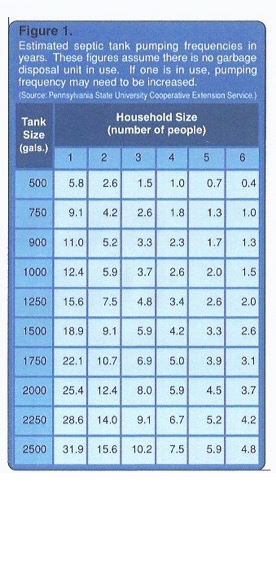Frequently Asked Questions
Pumpers Plus FAQ
1) How often should I pump my septic tank?
This chart is the only one I could find that wasn’t written by someone like myself, who profits from pumping septic tanks. I personally think this chart is premature on the pumping schedule. I use the following simple formula: an average family of 4 on an average 1000 gallon septic tank should have the tank pumped every 4 years. Of course, every situation is different and different variables could affect the frequency of required pumping, for example: kids vs adults, males vs females, etc.
Your septic tank is a trap. It traps the solid waste and allows the water to drain out into the drain field. Just like any other trap, when it is full, it cannot trap anymore solids. When this happens, the solids enter the drain field which will ruin it.
Of course, this is just my basic “rule of thumb” and my personal and professional opinion. If you have any additional questions or concerns, I would be happy to address you individually. Please feel free to contact me at 888-654-5787.
Thank You!
Shane
Pumpers Plus
2) Why should I pump my septic tank?
A septic tank is a trap. It traps the solid waste and allows the liquid to drain off into a drain field. Just like any other kind of trap, when it is full it cannot trap anymore solids. If this happens, it allows the solids into the drain field which can damage it. And replacing or repairing a drain field can be very expensive. An analogy: If you don’t change the oil in your car on a regular basis, it will cost a lot to replace or repair a damaged motor. Just like changing the oil in your car every 3000 miles, routine septic cleaning will increase the life of your drain field.
3) What kind of access do you need to pump my septic tank?
We need direct access to your tank. Most septic tanks have multiple lids on the top of them. We can pump your tank from any of these lids; however, some tanks have different sizes of lids. The bigger the access to your septic tank, the better we can clean it. Some of the deeper septic tanks have risers or access pipes on them which brings the access lid closer to ground level.
4) Where is my septic tank?
Septic tanks are usually 8 to 20 feet out from the house. But the location of each tank is all up to the builder & the inspector. The only certain thing is that the top of your septic tank is deeper in the ground than the lowest drain in your house.
5) How do I find my septic tank?
The easiest and cheapest way is to contact your County Health Department. They should have a diagram of your system. If not, some health departments will come to your property and send a locator down the sewer line for a small fee. If all else fails, you can try a rooter company. Most of them have locators; however, each company charges a different rate. Call around to get the best price and best company for you and your needs.
6) How do I know if my drainfield is working?
The drainfield pipe exits the septic tank on the side of the tank at the top. If you pull the lid and the water level is approximately 6 inches from the top of the tank, your drainfield is probably working fine. If the water is at the very top or overflowing, you probably have drainfield issues. Some septic tanks are different (especially homemade tanks), so this isn’t always the case.
7) I just pumped my septic tank, why is it full again already?
If your septic tank is 1000 gallons, after you have run 1000 gallons of water in your house, it will sit at a full level. This way, your baffles in your septic tank can start the separation process. For more information, please refer to questions 6 & 2.


